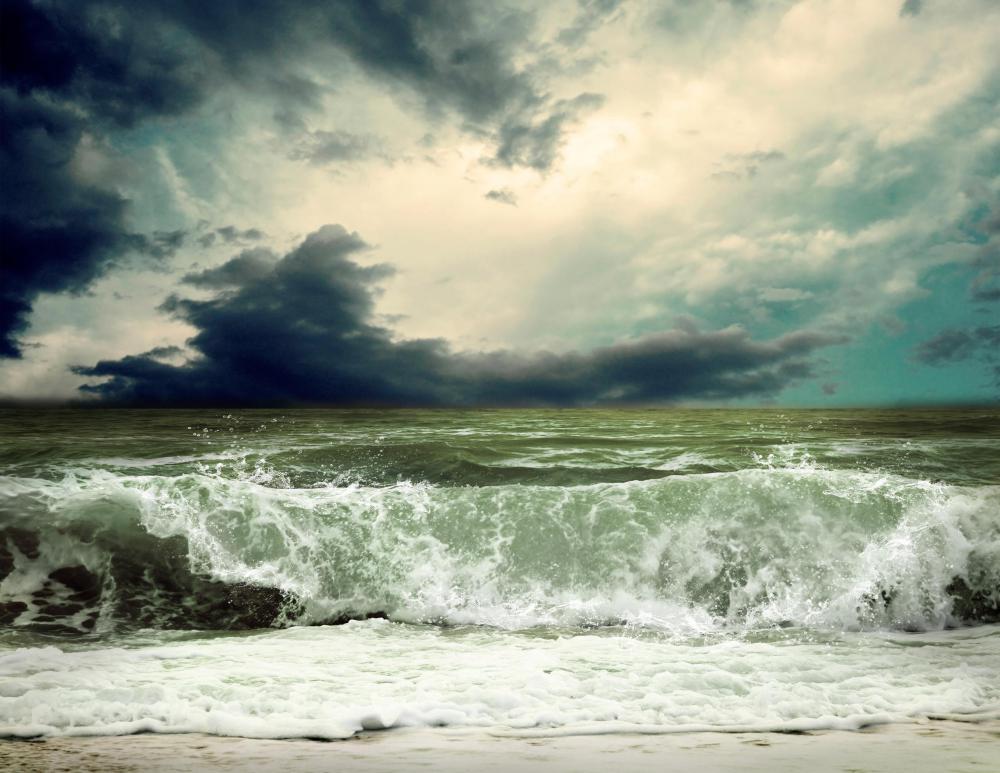At EasyTechJunkie, we're committed to delivering accurate, trustworthy information. Our expert-authored content is rigorously fact-checked and sourced from credible authorities. Discover how we uphold the highest standards in providing you with reliable knowledge.
What is a Marine Barometer?
A marine barometer is a tool used to measure atmospheric pressure and predict weather systems at sea. Traditionally, marine barometers have been made of mercury. Mercury rises or falls in relation to air pressure and temperature, and when contained in a barometric chamber, can accurately predict changes in weather and coming storms. While mercury barometers remain popular, they are increasingly being replaced by copper-based barometers and digital barometers. These types of barometers have the same weather-predicting goals as traditional mercury barometers, but attempt to meet those goals through the use of newer technology.
A barometer works by measuring the pressure of the surrounding air. The first barometers were simple inverted glass tubes of mercury, an element known to be sensitive to changes in pressure and temperature. The mercury rises and falls in the tube with changes in air pressure. When the air pressure is high, it pushes down on the mercury outside the tube, and the mercury inside the tube rises; when pressure is low, the mercury falls. Scientists learned to discern what rises and falls beyond certain thresholds meant in terms of changing weather. Changes in weather are closely correlated with changes in air pressure.

Accurate weather prediction was particularly important to sailors and seamen of merchant voyage ships in ancient times. Knowing that a squall was coming could allow a crew to change course, or batten down the hatches before being surprised with choppy seas, strong winds, and high waves. Carrying glass tubes of mercury aboard ships is not necessarily the safest thing to do, however. The tubes are fragile, the seas are often rough, and loose mercury can have profoundly negative health effects. The marine barometer was developed commercially in order to give seafarers a convenient and portable means of predicting atmospheric changes at sea.

A marine barometer usually works alongside other marine weather indicators, including marine thermometers and marine anemometers. Marine thermometers measure the temperature of the water, which can alert captains of many things, from coming storms to approaching shallow water. A marine anemometer measures wind speed and direction.
Traditional marine barometers were small glass tubes, reminiscent of thermometers, encased in larger protective boxes. These barometers were calibrated to align with certain readings going up the side of the box face. The readings usually indicated both the units of pressure, as well as their plain language translations: “fair,” “rain,” “storm,” and the like. They were designed to be mounted, usually on the wall of the ship’s navigational chamber.

As technology advanced, so did barometric technology. Although mercury barometers are frequently regarded as the most accurate, other models have followed. One common mercury marine barometer alternative is a copper alloy-based barometer known as an aneroid barometer.
An aneroid barometer is made up of small metal cell with a spring. The cell is surrounded by a metal alloy of copper and beryllium. As the air pressure outside the cell changes, the spring within the cell expands and contracts, and these movements cause a dial on the barometer’s face to move, as well. Aneroid barometers often have faces that resemble clocks, with a single dial that points to different measurements and weather conditions. Aneroid barometers became popular mercury alternatives for marine uses, as well as for home use.
The 20th century saw another barometer development with the introduction of the digital, or electronic, marine barometer. Digital barometers work by translating electronic readings of air pressure and temperature changes into weather predictions. Most digital barometers take humidity, air pressure, temperature, and wind speed into account when producing readings. Some digital barometers rival the accuracy of mercury barometers. The majority of modern ship captains rely on a host of digital technology to anticipate weather changes at sea, and a digital marine barometer is usually among the favored tools. Mercury marine barometers are still used, but are far less common than they once were, and as of 2010, were rarely ever newly manufactured.
AS FEATURED ON:
AS FEATURED ON:













Discuss this Article
Post your comments